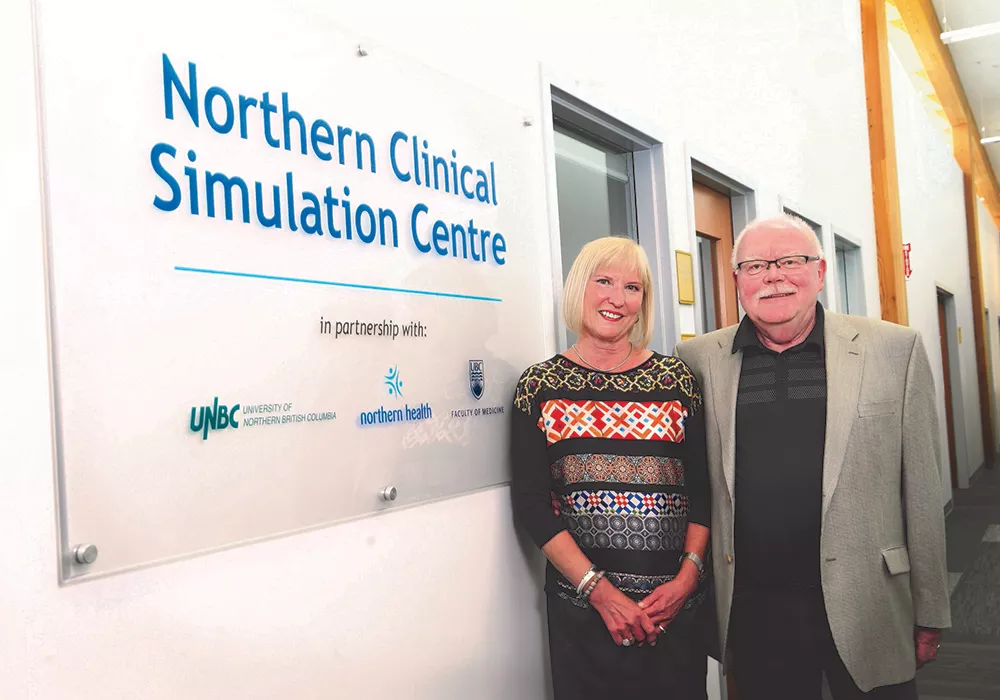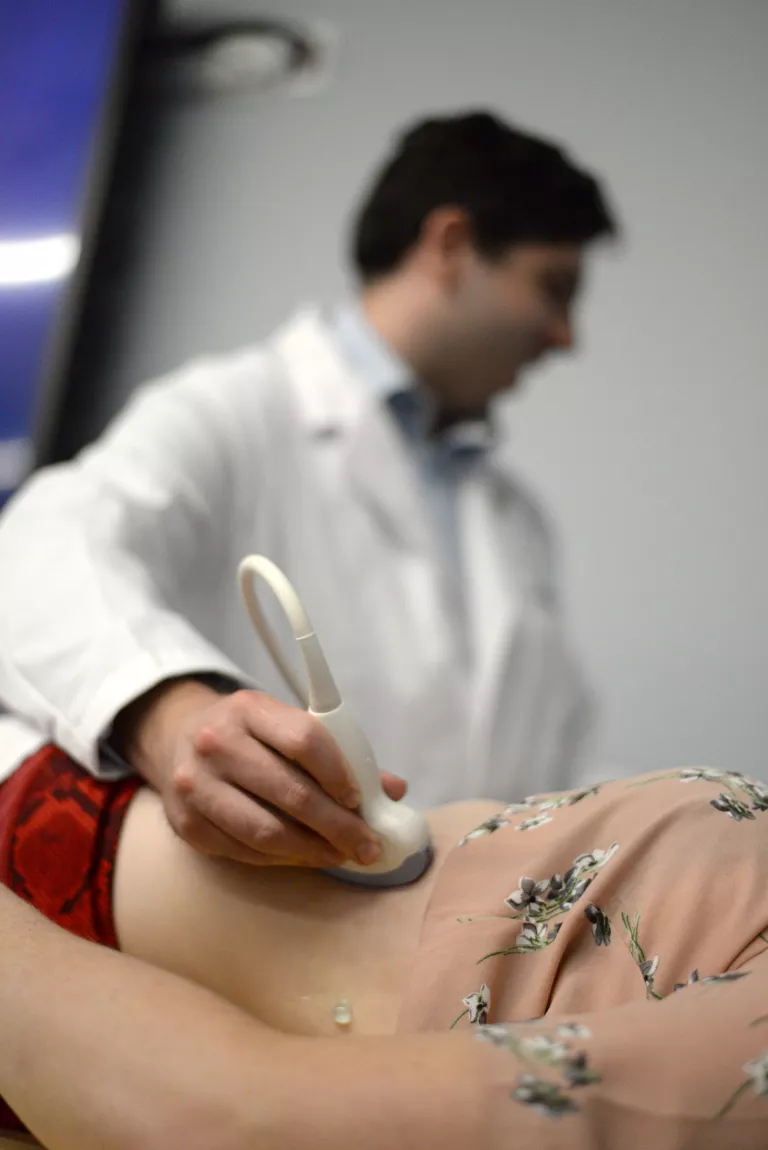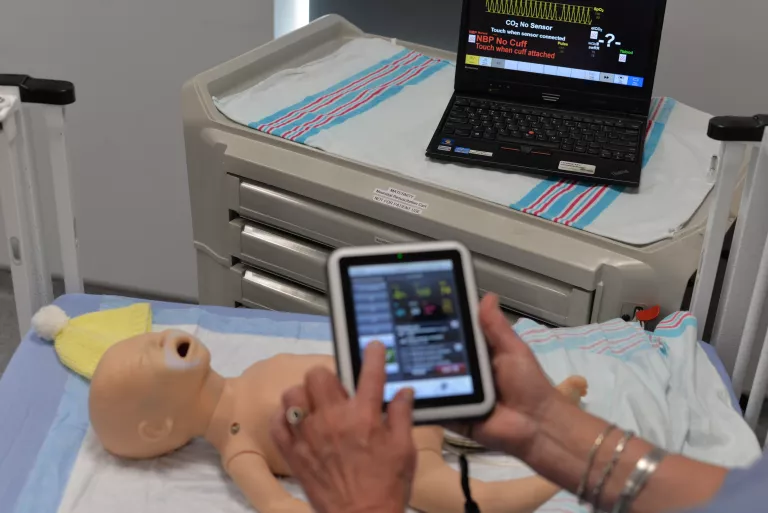Collaborating to Improve Patient Care
Through their philanthropy, Ann Marie and Steve Henderson, want to encourage collaboration. Their gift to UNBC's Northern Leadership Campaign is strengthening teaching excellence in the Family Nurse Practitioner program by helping students gain the knowledge they need to use point-of-care ultrasounds in practice. At the same time, the couple is supporting the Northern Clinical Simulation centre through the Spirit of North Healthcare Foundation, making it easier for medical professionals and students to improve their confidence and competence.

With the swipe of a finger, registered nurse Kyla Redlon can change the heart sounds of a simulated patient, making it easier for her to lead training sessions for nurses at Northern Health.
With the precise movement of a handheld ultrasound sensor, University of Northern British Columbia (UNBC) Family Nurse Practitioner student Rebecca Irving can conduct abdominal aortic aneurysm screening on a patient in a clinic.
Both Redlon and Irving are using equipment purchased thanks to gifts from Ann Marie and Steve Henderson. The couple are long-time supporters of both the Spirit of the North Healthcare Foundation and UNBC. They recently made donations to both institutions aimed at fostering collaboration and improving patient care across Northern B.C.
“Teams need to collaborate, communities need to collaborate and institutions need to collaborate,” Steve Henderson says. “We’ve been trying to promote that idea whenever we can and we hope these gifts send that message.”
The gift to Spirit of the North Healthcare Foundation supports Northern Clinical Simulation, through the purchase of a SimPad PLUS, two monitors for simulated patients and a simulated amputated arm. The new equipment will allow the simulation lab to enhance ongoing training and conduct more outreach to medical professionals across the region.
“The simulation lab is incredible,” says Ann Marie Henderson, who works as a social worker at the University Hospital of Northern British Columbia (UHNBC). “It gives people an opportunity to improve their skills and it encourages multidisciplinary teamwork.”
The donation to UNBC is directed to the Family Nurse Practitioner (FNP) program and will be used to purchase a point of care ultrasound unit for training purposes. The handheld ultrasound devices can be used by medical professionals to conduct screenings and diagnose conditions in the clinic, potentially saving patients the time and travel of going to a radiology facility.
Family nurse practitioner students are trained using the cutting-edge technology so that when they graduate they will be able to easily integrate point of care ultrasound into their practice.
“New innovation sparks curiosity, excitement and interest,” says Linda Van Pelt, the Family Nurse Practitioner Program co-ordinator at UNBC. “It’s great for students when they’re at the edge of something new. Our classes have been so excited about learning how to use the ultrasound equipment and interpret the results.”
Students receive training on how to maneuver the ultrasound probe, which can be counter-intuitive and so requires equipment to allow students to practice the skill. The students also learn the theory behind ultrasounds, including what to look for when they are examining a mass or conducting a screening.
“It is very important for the Family Nurse Practitioner curriculum to stay up to date as technology advances, and give students the benefit of learning about new tools prior to entering practice,” Irving says. “I think UNBC is proactive to include this in the FNP curriculum.”

A Family Nurse Practitioner student learns how to use an ultrasound during a training session at the Learning and Development Centre at the University Hospital of Northern British Columbia.
In addition to the training she received in class, Irving further explored point of case ultrasounds in a class project. She examined how the technology is deployed in primary care settings to screen for abdominal aortic aneurysms.
“I hope to work in a primary care clinic with an underserved population where I will have a strong impact on long-term health outcomes,” she says. “Point of care ultrasound is very useful in a rural emergency setting, so if I ever do rural or remote work I will definitely utilize it in my practice.”
Prior to the Henderson’s donation, the Family Nurse Practitioner program did not have access to handheld point of care ultrasound units. The new equipment approximates what nurse practitioners will utilize in their practice.
“These devices provide another tool for nurse practitioners to support their diagnostic, clinical and treatment decision-making,” says Van Pelt. “For patients, it may save them from having to travel to have an ultrasound done; it may also allow them to begin their treatment plan sooner. In some cases, it will encourage people to get screening done, when they otherwise may have chosen not to do it.”
Being able to work through simulations of medical conditions is another important tool for all medical professionals.
Northern Clinical Simulation, located at UHNBC started as a partnership between Northern Health, University of British Columbia Faculty of Medicine Northern Medical Program and the UNBC School of Nursing. The program supports simulation based training opportunities for students and ongoing professional development for a wide range of medical professionals. Much of the initial equipment is now getting older and in need of replacement. New state-of-the-art equipment allows for an improved learning experience.
The five robotic patients, ranging from a newborn, to a maternal and neonatal birthing simulator, to an adult, can simulate a myriad of medical conditions.
The SimPad PLUS is the latest tool that makes it simpler for an educator to control the patients and create realistic training scenarios. The small, wireless portable tablet is equipped with intuitive software making it easier for educators across the region to put on training programs.
Redlon, the clinical nurse educator for the medical floor at UHNBC, uses the simulators to teach a dysrhythmia course and train newly hired nurses for code blue management.
“The benefit of the SimPad PLUS is I can take it to the ward or into a patient space so the nurses can practice in the same space where they work, which makes for a very enriching learning experience,” Redlon explains.
Prior to the Henderson’s donation, the simulation lab had two SimPad PLUS units to go with their five patients. Although the sims can be manipulated through software on laptops, the SimPad PLUS gives educators an effective tool to use the simulators. A third unit allows the lab to conduct more training in the hospitals as well as outreach to other centres across the region.
“A good example of outreach is being able to take a simulated patient from the parking lot, have a BC Ambulance paramedic team load the patient into an ambulance, do the hand-over and transfer to the health-care staff in the hospital or clinic and then evaluate how everybody works together as a team,” says Michael Lundin, co-ordinator Northern Clinical Simulation with Northern Health. “They don’t get to practice with each other very often. Simulation is giving them that opportunity to practice together as a team.”

The SimPad PLUS, one of the items purchased with the support of the Henderson, makes it easier for educators to lead simulation sessions.
The SimPad PLUS can also provide real-time feedback, including during cardiopulmonary resuscitation (CPR) training.
“You can set the SimPad PLUS right next to the Resusci Anne and while you do compressions you can see exactly how you’re doing for your rate and depth,” Lundin says. “You can see your speed, so if you’re doing less than 100 or more than 120, it gives you feedback right there.”
By engaging in regular simulation training, it improves both the confidence and competence of health-care providers. Ann Marie Henderson says it can also give patients the peace of mind that their doctors, nurses and other medical professionals are prepared to deal with any health crisis that might arise.
“People don’t think about health care until they need it. Often that occurs in a crisis, or when someone begins to have chronic health problems,” she says.
The Hendersons are thrilled their philanthropy is being used to support training for health-care professionals across the region. They believe one family can make a positive outcome in the lives of many others through strategic giving.
“The goal of our gifts is to contribute to healthy communities and to encourage others to give as well,” Steve Henderson says.